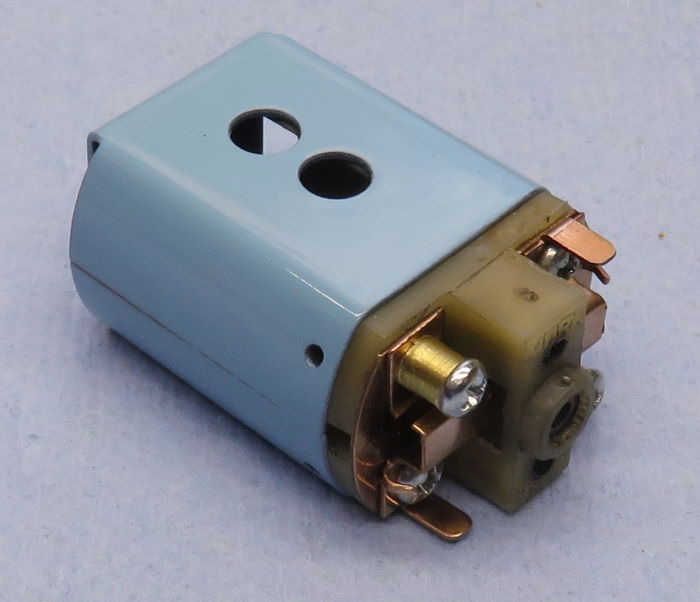Whenever I get enough parts (*which ain't all that often!) to cobble-together one of these, I don't sit on them...I build them and wind them. This one has tabbed hoods, but with the larger "36D" sized brush hoods that I think some of them came with, as well as the correct magnets. The setup is done so...time to get busy (er).


The Mura 16D..."hens teeth with two holes"
#1

Posted 14 October 2019 - 01:46 PM
- slotbaker, Jencar17, Alchemist and 5 others like this
#2

Posted 14 October 2019 - 04:04 PM
I really like the color of the can John!
but with the larger "36D" sized brush hoods
Is there an advantage of having the larger brush hoods please?
Thank you.
Ernie
#3

Posted 14 October 2019 - 04:37 PM
Sweeeet the can will match the powder coating on the arm ![]()
- havlicek likes this
Paul Wolcott
#4

Posted 14 October 2019 - 05:45 PM
I really like the color of the can John!
Is there an advantage of having the larger brush hoods please?
Thank you.
Ernie
The larger brushes will run better with the larger com Ernie. The smaller brushes would work just fine as well...you just should stay away from the large brushes and small diameter coms. Also, the practical reason is that it's far easier to source the larger brushes, as they are pretty much the modern "standard".
Sweeeet the can will match the powder coating on the arm
Thanks Pablo...I can make the color thing happen with the powder coating alright. ![]()
- Pablo likes this
#5

Posted 14 October 2019 - 06:55 PM
#6

Posted 14 October 2019 - 08:09 PM
Hey John ………...what is the best solvent to use to clean motors when they are all apart?
thanx
Buzz-A-Rama forever in our hearts
RIP... Buzzy and Dolores
#7

Posted 14 October 2019 - 08:53 PM
I had built two green can motors back in I think 1972 that were that color, both had ball bearings on both ends and elephant ears. One was a 20-26 the other was a 19-25, the 26 gauge was an animal at the track in Oakland so I pulled it to try the 25, it was very fast but I felt the 26 was going to a better race motor. by the time i got back to my box someone had lifted the 26, boy was i ticked! of the two motors i had stolen both were in California. the next usra race was going to be a Jack"s in Mesa so i ran a Mura Gp 40 as it ran like my 26, took second in pro main.
Jesse Gonzales
- S.O. Watt and havlicek like this
#8

Posted 15 October 2019 - 04:59 AM
It's a wear thing, the bigger brushes last longer for open like arms. It was one big reliability improvement when introduced.
It's not just a wear thing Chris. The size of the brush face in relation to the size of the com segments changes the amount of brush overlap. In some cases, the larger brushes can cause motors to run poorly with smaller diameter coms. I've also seen it said that timing is affected as well.
Hey John ………...what is the best solvent to use to clean motors when they are all apart?
thanx
Hi Nicky, I've taken to only using denatured alcohol, although some use things like electrical contact cleaner. I used to use acetone as well, but the stuff is (IMO) not necessary. Denatured alcohol is relatively "safe" (*although flammable) and clean, evaporating with no residue to speak of. It's also a good way to "dry" motors because it will mix with water and help remove it when the mixture evaporates faster than water alone would. The other solvent that can work really well is...water.
- Jesse Gonzales likes this
#9

Posted 15 October 2019 - 05:39 AM
I had built two green can motors back in I think 1972 that were that color, both had ball bearings on both ends and elephant ears. One was a 20-26 the other was a 19-25, the 26 gauge was an animal at the track in Oakland so I pulled it to try the 25, it was very fast but I felt the 26 was going to a better race motor. by the time i got back to my box someone had lifted the 26, boy was i ticked! of the two motors i had stolen both were in California. the next usra race was going to be a Jack"s in Mesa so i ran a Mura Gp 40 as it ran like my 26, took second in pro main.
Jesse Gonzales
I...hate...thieves, and I'm not talking about taking a loaf of bread because someone is starving Jesse.
Anywho, I was thinking of *possibly* going as hot as a #26 with this motor...or as "mild" as a #28 or even a #29.
#10

Posted 15 October 2019 - 06:57 AM
The other solvent that can work really well is...water.
...and dishes soap !
- havlicek likes this
#11

Posted 15 October 2019 - 08:13 AM
...and dishes soap !
Absolutely Maurizio!
#12

Posted 15 October 2019 - 07:29 PM
the hottest i ever tried in a green can was a 26/27, it blew the comm in the bank at speed and sport, the 26/28 one lived a bit longer but it too bit the big green one in the bank. Those were my attempts to run with the crop of 23's that Bill Steube had some of his guys running.
i used to use Joy dish-washing soap on everything, even de-glueing me after a race, Joy and a wire brush followed up by a spray of cheap hairspray to seal the chassis from corrosion.
one thing is for sure, whatever John puts in there it will be done with craftsmanship of the highest order.
Jesse Gonzales
- Tom Katsanis likes this
#13

Posted 15 October 2019 - 09:57 PM
- havlicek likes this
#14

Posted 16 October 2019 - 06:02 AM
Thanks for the info Chris!
If you use this bigger bush with a Hawk 6 size com it is common to narrow the brush for best performance.
There's a bit of strangeness in all that. On some motors with the common small O.D. Asian coms, the larger brushes seem to run at least "OK". On some others that at least "seem" pretty much the same, they run "not so OK". I haven't figured out exactly what that's all about though and mostly stay away from the small coms.
- olescratch likes this
#15

Posted 16 October 2019 - 07:43 PM
#16

Posted 17 October 2019 - 05:56 AM
Without narrowing the 36D brush it is so wide that it spans a segment nearly shorting the one under the brush with those adjacent segments on a Hawk 6 com. This can't be good for performance. I tested once with everything the same and the narrowed brushes were about half a tenth faster on a 3.5 sec Group F lap on a 145 ft Hillclimb.
This is one of the times when these motors probably work better BEFORE fully breaking them in and using non-radiused brushes. ![]()
- olescratch likes this
















